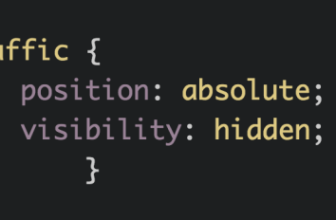What Pandu Nayak Taught Me About SEO

[ad_1]
Okay, Pandu Nayak didn’t exactly teach me about SEO.
But his October 18 anti-trust hearing testimony was both important and educational. And I’m a better SEO when I understand how Google really works.
Pandu Nayak is Vice President of Search working on various aspects of Search Quality. He’s been at Google for 18 years and is the real deal when it comes to search at Google.
I’m going to highlight areas from the October 18 transcript (pdf) I find notable or interesting and afterwards tell you how I apply this to my client work. The entire transcript is well worth your time and attention.
In all of the screenshots the Q. will be Department of Justice counsel Kenneth Dintzer, The Court will be Judge Amit P. Mehta while A. or The Witness will be Pandu Nayak.
Navboost
Why the interest in Navboost?
Remember, it was said to be “one of Google’s strongest ranking signals” and is mentioned 54 times in this transcript, making it the fifth most mentioned term overall.
Nayak also acknowledges that Navboost is an important signal.
I touched on Navboost in my It’s Goog Enough! piece and now we have better explanations about what it is and how Google uses it.
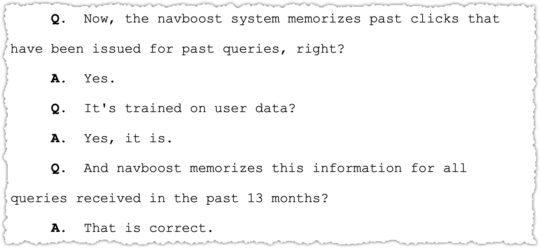
Navboost is trained on click data on queries over the past 13 months. Prior to 2017, Navboost was trained on the past 18 months of data.
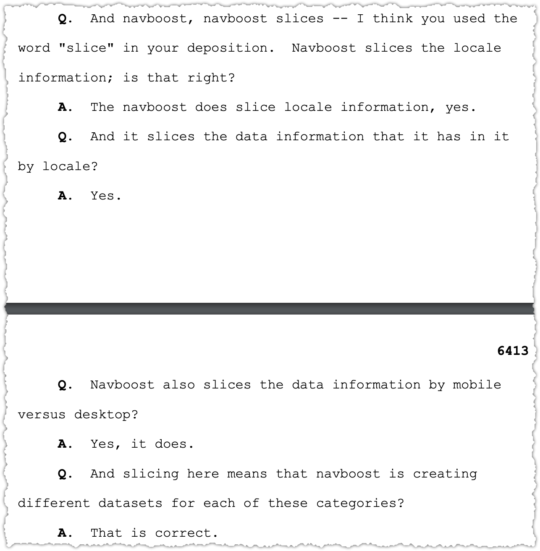
Navboost can be sliced in various different ways. This is in line with the foundational patents around implicit user feedback.
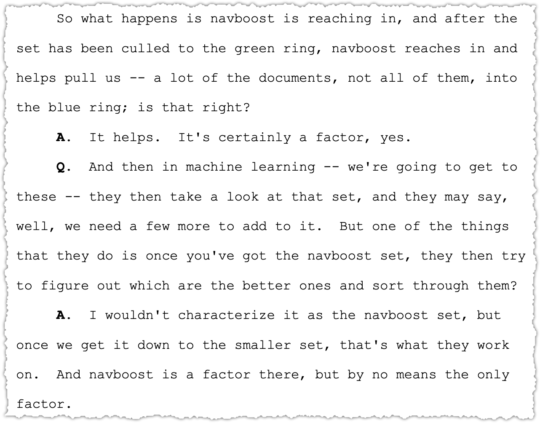
There are a number of references to moving a set of documents from the “green ring” to the “blue ring”. These all refer to a document that I have not yet been able to locate. However, based on the testimony it seems to visualize the way Google culls results from a large set to a smaller set where they can then apply further ranking factors.
There’s quite a bit here on understanding the process.
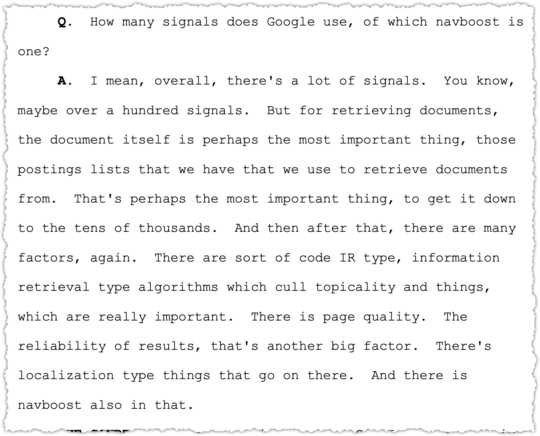
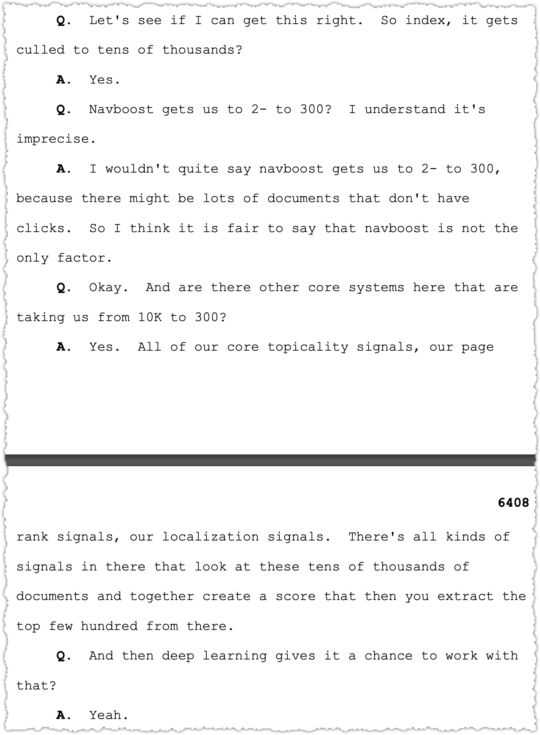
Nayak is always clear that Navboost is just one of the factors that helps in this process. And it’s interesting that one of those reasons is some documents don’t have clicks but could still be highly relevant. When you think about it, this has to be the case or no new content would ever have a chance to rank.
There is also interesting insights into the stages of informational retrieval and when they apply different signals.
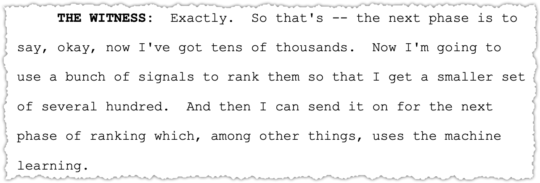
I assume the deep learning and machine learning signals are computationally expensive, which is why they are applied to the final set of candidate documents. (Though I’ve read some things about passage ranking that might turn this on it’s head. But I digress.)
So Navboost is still an important signal which uses the memorized click data over the last 13 months.
Glue
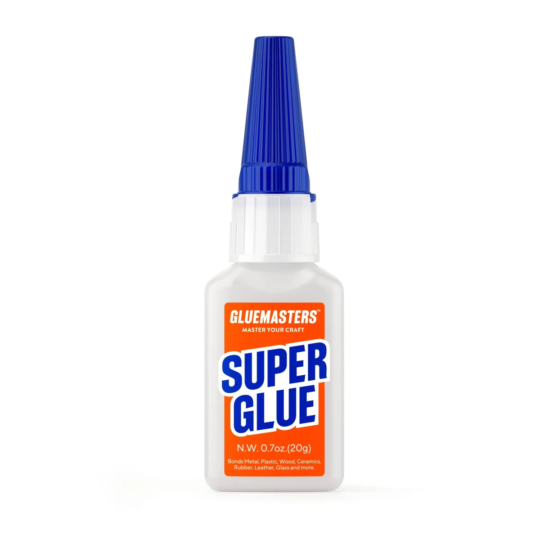
Glue is the counterpart to Navboost and informs what other features are populated on a SERP.
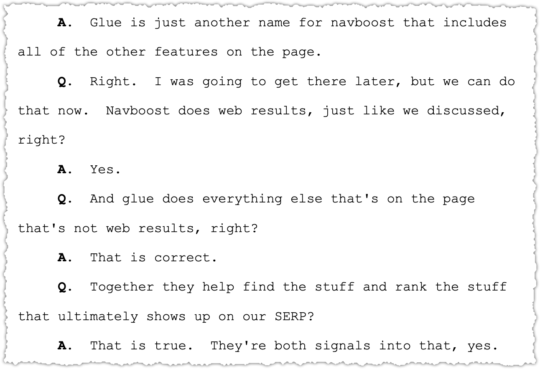
Though not explicitly stated, if Glue is another name for Navboost but for all of the other features on the page then it stands to reason that it’s logging the user interactions with features for all queries over the last 13 months.
So it might learn that users are more satisfied when there’s a video carousel in the SERP when searching for a movie title.
Tangram (née Tetris)

The system that works to put all of the features on a SERP is called Tangram.
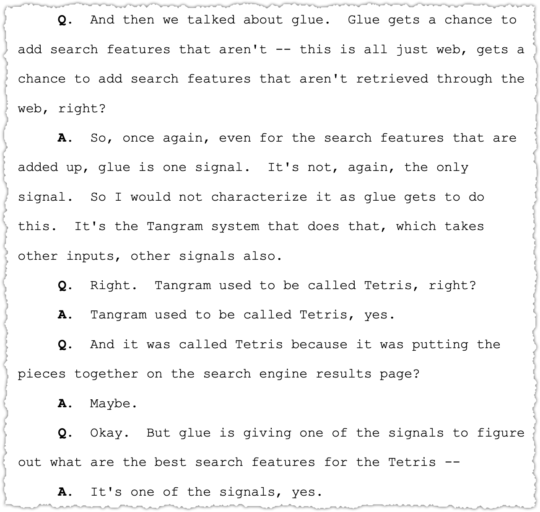
I kind of like the name Tetris but Tangram essentially has the same meaning. It’s a complex and intricate puzzle.
RankBrain
Now we can leave click data behind and turn our attention to the modern deep learning models like RankBrain. Right? Well … here’s the thing.
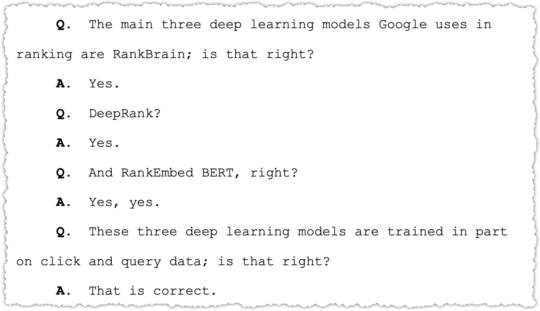
All of the deep learning models used by Google in ranking are trained, in part, on click and query data. This is further teased out in testimony.
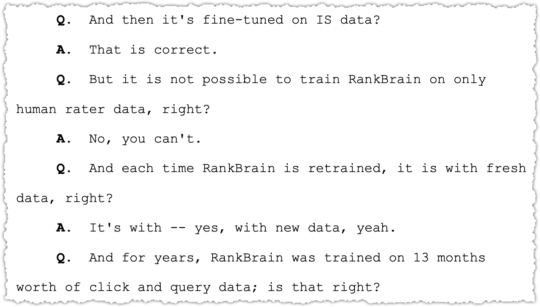

None of this surprises me given what I know. In general, these models are trained on the click data of query-document pairs. Honestly, while I understand the concepts, the math in the papers and presentations on this subject are dense to say the least.
As mentioned above, RankBrain is run on a smaller set of documents at the tail end of ranking.
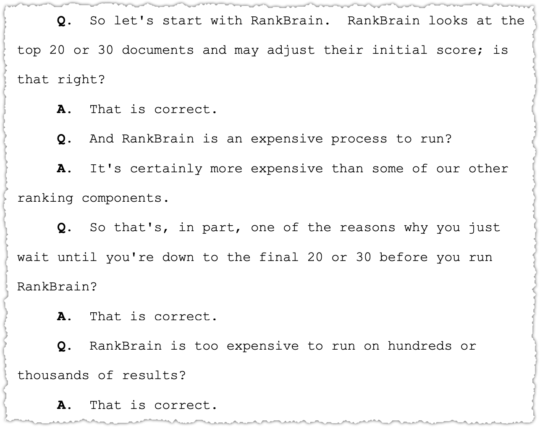
I’m not quite sure if RankBrain is part of the ‘official’ rank modifier engine. That’s a whole other rabbit hole for another time.
RankEmbed BERT
What about RankEmbed BERT?
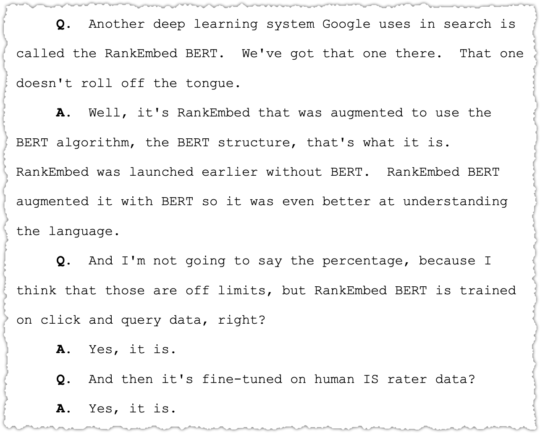
Embed is clearly about word embeddings and vectors. It’s essentially a way to turn words into math. Early models like word2vec were context insensitive. BERT, due to it’s bi-directional nature, provided context-sensitive embeddings. I cover a bunch of this in Algorithm Analysis In The Age of Embeddings.
This was a major change in how Google could understand documents and may have made Google a bit less reliant on implicit user feedback.
DeepRank
DeepRank seems to be the newest and most impactful deep learning model used in ranking. But it’s a bit confusing.
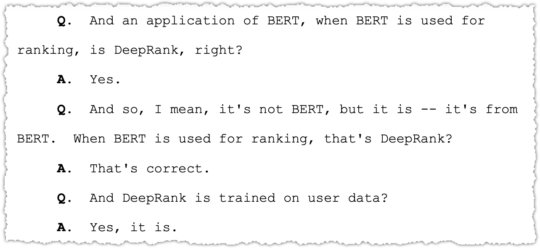
It seems like DeepRank is not exactly different but just when BERT is using for ranking purposes.
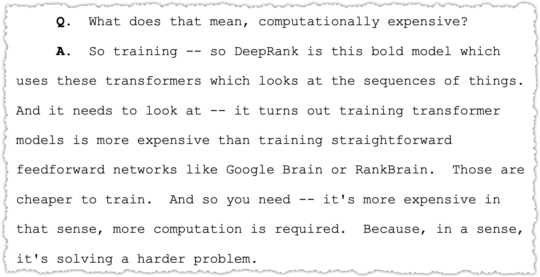
It would make sense that DeepRank uses transformers if it’s indeed a BERT based model. (Insert Decepticons joke here.)
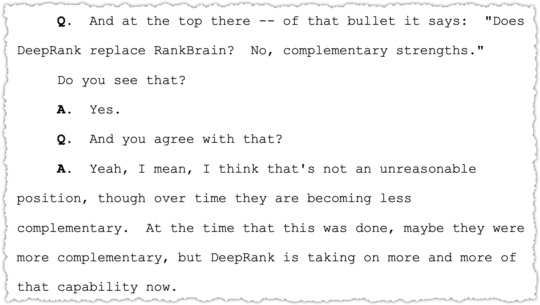
Finally we get some additional color on the value of DeepRank in comparison to RankBrain.
There’s no question that Google is relying more on deep learning models but remain hesitant (with good reason) to rely on them exclusively.
Information Satisfaction (IS) Scores

You may have noticed references to human rates and IS scores. Nowhere in the transcript does it tell you what IS stands for but Google’s Response to ACCC Issues Paper (pdf) contains the meaning.
“Google tracks search performance by measuring “information satisfaction” (IS) scores on a 100 point scale. IS is measured blind by Search Quality Raters …”
So IS scores are from human raters via the Search Quality Evaluator Guidelines (pdf).
There’s a large description about how these ratings are conducted and how they’re used from fine tuning to experimentation.
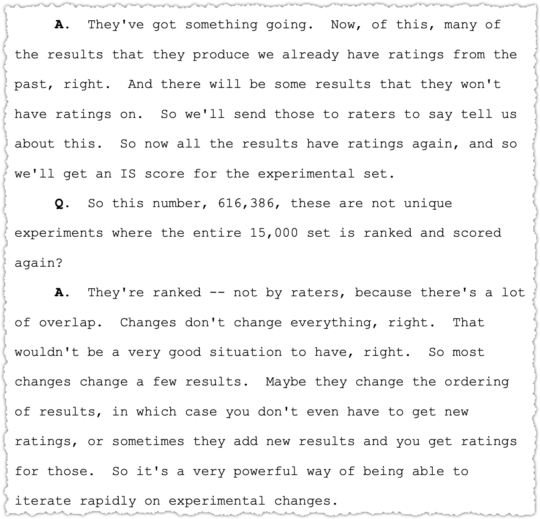
The number that pops out for me is the 616,386 experiments which is either the number of experiments from 2020 alone or since 2020.
I struggle a bit with how this works, in part because I have issues with the guidelines, particularly around lyrics. But suffice to say, it feels like the IS scores allow Google to quickly get a gut check on the impact of a change.

While not explicitly said, there is mention to columns of numbers that seem to reference the experiment counts. One is for IS score experiments and the other seems to be for live testing.
Interleaving
Live tests are not done as traditional A/B tests but instead employ interleaving.
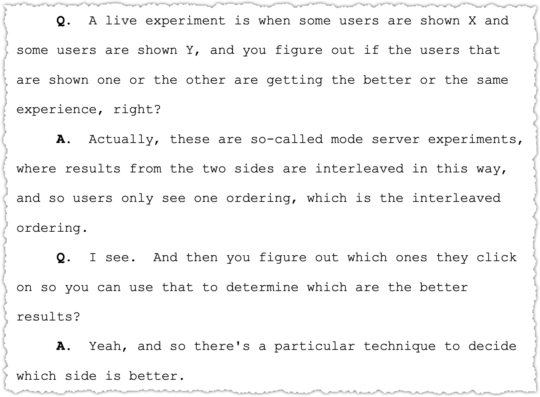
There are a number of papers on this technique. The one I had bookmarked in Raindrop was Large-Scale Validation and Analysis of Interleaved Search Evaluation (pdf).
I believe we’ve been seeing vastly more interleaved tests in the last three years.
So Frickin What?!

A number of people have asked me why I care about the mechanics and details of search. How does it help me with clients? Someone recently quipped, “I don’t see how this helps with your SEO shenanigans.”
My first reaction? I find the topic interesting, almost from an academic perspective. I’m intrigued by information retrieval and how search engines work. I also make a living from search so why wouldn’t I want to know more about it?
But that’s a bit of a lazy answer. Because I do use what I learn and apply it in practice.
Engagement Signals
For more than a decade I’ve worked under the assumption that engagement signals were important. Sure I could be more precise and call them implicit user feedback or user interaction signals but engagement is an easier thing to communicate to clients.
That meant I focused my efforts on getting long clicks. The goal was to satisfy users and not have them pogostick back to search results. It meant I was talking with clients about UX and I became adamant about the need to aggregate intent.
Here’s one example I’ve used again and again in presentations. It’s a set of two slides where I ask why someone is searching for a ‘eureka 4870 manual’.
Someone usually says something like, ‘because the vacuum isn’t working’. Bingo!
Satisfying active intent with that manual is okay.
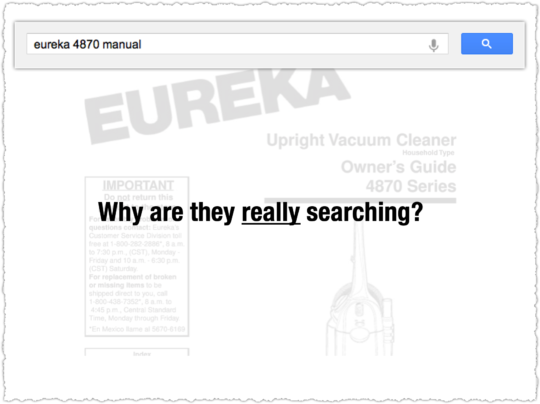
But if you know why they’re really searching you can deliver not just the manual but everything else they might need or search for next.
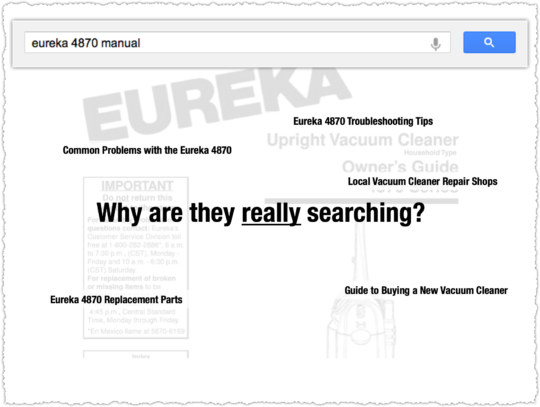
Let’s go with one more example. If you are a local directory site, you usually have reviews from your own users prominently on the page. But it’s natural for people to wonder how other sites rate that doctor or coffee shop or assisted living facility.
My recommendation is to display the ratings from other sites there on your own page. Why? Users want those other ratings. By not having them there you chase users back to the search results to find those other ratings.
This type of pogosticking behavior sends poor signals to Google and you may simply never get that user back. So show the Yelp and Facebook rating! You can even link to them. Don’t talk to me about lost link equity.
Yes, maybe some users do click to read those Yelp reviews. But that’s not that bad because to Google you’ve still satisfied that initial query. The user hasn’t gone back to the SERP and selected Yelp. Instead, Google simply sees that your site was the last click in that search session.
No tricks, hacks or gimmicks. Knowing engagement matters simply means satisfying users with valuable content and good UX.
Navboost
Even before I knew about Navboost I was certain that brands had an advantage due to aided awareness. That meant I talked about being active on social platforms and pushed clients to invest in partnerships.
The idea is to be everywhere your customer is on the Internet. Whether they are on Pinterest or a niche forum or another site I want them to run into my client’s site and brand.

Perhaps the most important expression of this idea is long-tail search optimization. I push clients to scale short-form content that precisely satisfies long-tail query intent. These are usually top-of-funnel queries that don’t lead to a direct conversion.
Thing is, it is some of the cheapest form of branding you can do online. Done right, you are getting positive brand exposure to people in-market for that product. And that all adds up.
Because the next time a user searches – this time a more mid or bottom-of-funnel term – they might recognize your brand, associate it with that prior positive experience and … click!
I’ve proven this strategy again and again by looking at first touch attribution reports with a 30, 60 and 90 day look back window. This type of multi-search user-journey strategy builds your brand and, over time, may help you punch above your rank from a CTR perspective.
Here’s one more example. I had a type of penicillin moment a number of years ago. I was doing research on one thing and blundered into something else entirely.
I was researching something else using Google Consumer Surveys (RIP) when I learned users wanted a completely different meta description.
Meta description! Not a ranking factor right? It’s not a direct ranking factor.
When we changed from my carefully crafted meta description template to this new meta description the CTR jumped across the board. Soon after we saw a step change in ranking and the client became the leading site in that vertical and hasn’t looked back.
NLP
Google understands language differently than you and me. They turn language into math. I understand some of it but the details are often too arcane. The concepts are what really matter.
What it boils down to in practice is a vigilance around syntax. Google will often say that they understand language better as they launch something like BERT. And that’s true. But the reaction from many is that it means they can ‘write for people’ instead of search engines.
In theory that sounds great. In practice, it leads to a lot of very sloppy writing that will frustrate both your readers and Google. 12 years ago I urged people to stop writing for people. Read that piece first before you jump to conclusions.
Writing with the right syntactic structure makes it easier for Google to understand your content. Guess what? It does the same for users too.
I have another pair of slides that show an exaggerated difference in syntax.


I’d argue that content that is more readable and easier to understand is more valuable – that je ne sais quoi quality that Google seeks.
Nowhere is syntax more important than when you’re trying to obtain a featured snippet.
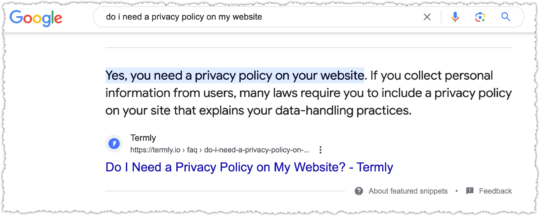
However, it’s also important for me to understand when Google might be employing different types of NLP. Some types of content benefit from deep learning models like BERT. But other types of content and query classes may not and still employ a BoW model like BM25.
For the latter, that means I might be more free to visualize information since normal article content isn’t going to lead to a greater understanding of the page. It also means I might be far more vigilant about the focus of the page content.
Interleaving
Google performs far more algorithm tests than are reported on industry sites and the number of tests has accelerated over the last three years.
I see this because I regularly employ rank indices for clients that track very uniform sets of query classes. Some of these indices have data for more than a decade.
What I find are patterns of testing that produce a jagged tooth trend line for average rank. These wind up being either two-steps forward and one-step back (good) or one-step forward and two-steps back (bad).
I’m pretty sure I can see when a test ends because it produces what I call a dichotomous result where some metrics improve but others decline. An example might be when the number of terms ranking in the top three go up but the number of terms ranking in the top ten go down.
Understanding the velocity of tests and how they might be performed allows me to calm panicked clients and keep them focused on the roadmap instead of spinning their wheels for no good reason.
TL;DR
Pandu Nayak’s anti-trust testimony provided interesting and educational insights into how Google search really works. From Navboost and Glue to deep learning models like DeepRank, the details can make you a better SEO.
Notes: Auditory accompaniment while writing included OutRun by Kavinsky, Redline by Lazerhawk, Vegas by Crystal Method and Invaders Must Die by The Prodigy.
The Next Post: Google Cache Bookmarklets
The Previous Post: It’s Goog Enough!
[ad_2]
Source link




